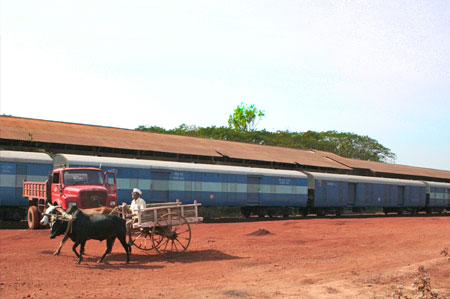|
| Help | |
| You are here: Rediff Home » India » News » First Look |
|
 The electronification of India's elections and its railway reservation process transformed the popular perception of IT and brought the capability of technology to millions of Indians.
The electronification of India's elections and its railway reservation process transformed the popular perception of IT and brought the capability of technology to millions of Indians. The highly efficient e-reservation has allowed Indians to bypass the long queues for tickets and the EVM considerably reduced the problem of stuffing ballots, writes Nandan M Nilekani in the series of extracts from his book Imagining India.
There were a couple of successful electronification initiatives, which, by demonstrating the capability of technology to millions of Indians across the country, were transforming popular opinion in its favour. One was the electronification of India's elections with the introduction of a colourful, pop-art style, easy-to-use voting machine, which became an enormous hit with Indian voters.
'It took us twenty-seven years to implement electronic voting from the time we conceived and built the machine,' the Chief Election Commissioner N Gopalaswami [Images] tells me. 'When we tried to use the machines in a 1981 Kerala [Images] by-election, one of the contenders challenged their validity but lost at the state's high court, so we went ahead.' But in the election, the politician who had fought against the machines won, and the loser challenged the result at the Supreme Court. 'The SC tossed out the results because the law required paper ballots.'
Amending the law took six years, and then the machines went on the backburner. In 2001, after a long hiatus, the Election Commission again tried the machines out. In Tamil Nadu, the All India Anna Dravida Munnetru Kazhakam, AIADMK leader J Jayalalithaa made a fuss, alleging that the machines were unreliable. 'This time, the Supreme Court threw her case out,' Gopalaswami says. 'Good for her, because she won that election.' Since then, it has been smooth sailing -- in 2004 all elections across the country had electronic voting, with one million machines deployed across over 700,000 polling booths.
India's elections have typically been corrupt and chaotic, with 'ballot-box stuffing' part of the nuts and bolts of getting yourself elected, and voting fraud in some areas have been as high as 40 per cent. The electronic voting machines (EVMs) considerably reduced the problem of ballot stuffing.
As Gopalaswami says, 'When one vote is cast, the machine takes twelve seconds to reactivate. So the "productivity" of the fraudsters goes down, since you can't just stuff bunches of paper into a box.' The time delay has also helped the Commission figure out when 'stuffing' has happened with a machine. 'If we spot a series where votes were cast every twelve seconds, we simply cancel that result,' he says.
Gopalaswami seems to take these challenges of our elections in his stride, and when he tells me of his technology-aided solutions to stop box-stuffing, I cannot miss the twinkle in his eyes. Recently, the commission began to clean up the system by digitizing other parts of the process -- such as using randomizing software to choose the presiding officers for election booths. 'There are exclusion parameters that the software uses, which eliminate, for example, the guys whose home town is in the district.' In addition, these presiding officers used to be selected a week before the election, which gave candidates enough time to ply him with his weakness of choice -- alcohol or money. The new software, however, chooses the name of the presiding officer on the day of the election. It has, the commissioner tells me cheerfully, really annoyed some candidates.
And the sincere ballot-stuffers bring artistry and skill to their efforts. As Gopalaswami points out, 'They can figure out elegant ways around regulation and anti-corruption measures. But IT helps us make it a lot harder for them.'
Another major initiative that transformed the popular perception of IT and brought India's masses in direct contact with it was the electronification of the railways. The Indian Railways is a huge part of travel for most Indians; it cris-crosses the length and breadth of the country and transports fourteen million passengers a day. The computerised reservation system could not have been a better introduction to the value of IT systems -- it was highly efficient and allowed the poor to bypass the long queues for tickets and the ineffectual, often exploitative bureaucracy.
At the railway ministry, I meet Sudhir Kumar, an IAS officer with a wide, infectious smile, one of the sharpest minds I have known, and a tendency to quote the management gurus Gary Hamel and C K Prahalad to get his point across. He is animated about how much computerising reservation and ticketing has helped the rail traveler. 'We transformed lives for a lot of people with computerised reservation systems,' he says. 'We freed up passengers from long queues, the mercy of touts and tickets being sold in the black. But there is so much more we can do with IT.'
One of his plans, he says, is 'electronic dispersal of tickets through railway kiosks'. He is hugely optimistic about the options technology offers in future services. 'Software, intelligently applied, can help us mine a lot more information on customer behaviour, and build dynamic pricing systems,' he says. I get a sense that while people in India see the present transformation of the railways as dramatic, for Sudhir things have just started rolling.
Imagining India: Ideas for the New Century by Nandan M Nilekani, Penguin Books India. Price Rs 699 | Buy the book on Rediff Shopping
Photograph: Rajesh Karkera
| Email | Print | Get latest news on your desktop |
|
|
| © 2009 Rediff.com India Limited. All Rights Reserved. Disclaimer | Feedback |